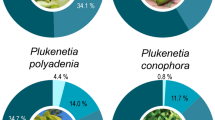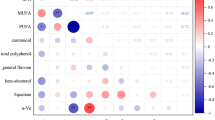Abstract
γ-linolenic acid (GLA, 18:3n-6) is a bioactive fatty acid (FA) that exerts several healthy actions; however, its occurrence is restricted to a few oils. The goal of this study was to detect GLA-rich Ribes species and cultivars (cv), and to achieve this the seeds of 7 Ribes taxa and 50 Ribes cv were surveyed for FA profiles. The highest GLA percentages were found in R. nigrum cv 'Plotnokistnaya', 'Volshebnica', 'Atlant' and 'Nara' (22.6, 22.1, 20.9, and 20.0% of total FA, respectively) and also in R. komarovii (19.6%) and R. nigrum var. sibiricum (18.3%). Stearidonic acid (SDA, 18:4n-3) had the highest values in both R. rubrum 'Konstantinovskaya' and R. niveum 'Smolyaninovskaya' (4.8%). GLA content ranged from 0.4 in some R. rubrum cv and R. niveum 'Smolyaninovskaya' to 3.5 g/100 g seeds in R. nigrum 'Plotnokistnaya'. Principal component analysis (PCA) was performed using PUFA profiles, which allowed grouping Ribes sections as well as black currant cv derived from different pedigree within the section Coreosma. All taxa and cv checked here are valuable by-product sources, given the high GLA percentages contained in their seed oils. Such cv could be used for healthy oils production, as well as for breeding to obtain new cv with improved GLA concentrations.
Graphical abstract


Similar content being viewed by others
Data Availability
Data are available upon request.
Code Availability
Not applicable.
Abbreviations
- ALA:
-
α-Linolenic acid
- ARA:
-
Arachidonic acid
- BC:
-
Black currant
- CV:
-
Cultivar
- D6D:
-
Δ6-Desaturase
- DHGLA:
-
Dihomo-γ-linolenic acid
- FA:
-
Fatty acid
- FAME:
-
Fatty acid methyl esters
- GLA:
-
γ-Linolenic acid
- LA:
-
Linoleic acid
- MUFA:
-
Monounsaturated fatty acid
- OA:
-
Oleic acid
- PA:
-
Palmitic acid
- PC:
-
Principal component
- PCA:
-
Principal component analysis
- PUFA:
-
Polyunsaturated fatty acid
- SDA:
-
Stearidonic acid
- SFA:
-
Saturated fatty acid
References
Das UN (2006) Essential fatty acids: biochemistry, physiology and pathology. Biotechnol J 1:420–439. https://doi.org/10.1002/biot.200600012
Sergeant S, Rahbar E, Chilton FH (2016) Gamma-linolenic acid, dihommo-gamma linolenic, eicosanoids and inflammatory processes. Eur J Pharmacol 785:77–86. https://doi.org/10.1016/j.ejphar.2016.04.020
Tosi F, Sartori F, Guarini P, Olivieri O, Martinelli N (2014) Delta-5 and delta-6 desaturases: crucial enzymes in polyunsaturated fatty acid-related pathways with pleiotropic influences in health and disease. Adv Exp Med Biol 824:61–81. https://doi.org/10.1007/978-3-319-7320-0_7
Innes JK, Calder PC (2018) Omega-6 fatty acids and inflammation. Prostaglandins Leukot Essent Fat Acids 132:41–48. https://doi.org/10.1016/j.plefa.2018.03.004
Alonso-Esteban JI, González-Fernández MJ, Fabrikov D, Torija-Isasa E, Sánchez-Mata MDC, Guil-Guerrero JL (2020) Hemp (Cannabis sativa L.) Varieties: Fatty Acid Profiles and Upgrading of γ-Linolenic Acid-Containing Hemp Seed Oils. Eur J Lipid Sci Tech 122:1900445. https://doi.org/10.1002/ejlt.201900445
Ruiz del Castillo ML, Dobson G, Brennan R, Gordon S (2002) Genotypic variation in fatty acid content of blackcurrant seeds. J Agric Food Chem 50:332–335. https://doi.org/10.1021/jf010899j
Lyashenko S, González-Fernández MJ, Gómez-Mercado FY, Yunusova S, Denisenko O, Guil-Guerrero JL (2019) Ribes taxa: a promising source of γ-linolenic acid-rich functional oils. Food Chem 301:125309. https://doi.org/10.1016/j.foodchem.2019.125309
Bakowska-Barczak AM, Schieber A, Kolodziejczyk P (2009) Characterization of Canadian black currant (Ribes nigrum L.) seed oils and residues. J Agric Food Chem 57:11528–11536. https://doi.org/10.1021/jf902161k
Lyashenko S, Yunusova S, López-Ruiz R, Vasfilova E, Kiseleva O, Chimitov D, Bahanova M, Bojko N, Guil-Guerrero JL (2021) Lipid fractions, fatty acid profiles, and bioactive compounds of Lithospermum officinale L. seeds. J Am Oil Chem Soc 98:425–437. https://doi.org/10.1002/aocs.12466
Paredes-López O, Cervantes-Ceja ML, Vigna-Pérez M, Hernández-Pérez T (2010) Berries: improving human health and healthy aging, and promoting quality life—a review. Plant Foods Hum Nutr 65:299–308. https://doi.org/10.1007/s11130-010-0177-1
Zdunić G, Šavikin K, Pljevljakušić D, Djordjević B (2016) Black (Ribes nigrum L.) and red currant (Ribes rubrum L.) cultivars. In: Simmonds MSJ, Preedy VR (eds) Nutritional composition of fruit cultivars. Academic Press, Cambridge, pp 101–126. https://doi.org/10.1016/B978-0-12-408117-8.00005-2
Brennan RM (2008) Currants and gooseberries. In: Hancock JF (ed) Temperate fruit crop breeding. Springer, Dordrecht, pp 177–196. https://doi.org/10.1007/978-1-4020-6907-9_6
Pluta S (2012) New challenges in the Ribes breeding and production. Acta Hortic 946:27–35. https://doi.org/10.17660/actahortic.2012.946.1
State Register of breeding achievements approved for use in the Russian Federation (in Russian) https://reestr.gossortrf.ru/. Accessed 23 March 2021
Pluta S, Żurawicz E (2009) The last twenty years of blackcurrant (Ribes nigrum L.) breeding work in Poland. Acta Hortic 814:309–314. https://doi.org/10.17660/actahortic.2009.814.48
Basegmez HIO, Povilaitis D, Kitrytė V, Kraujalienė V, Šulniūtė V, Alasalvar C, Venskutonis PR (2017) Biorefining of blackcurrant pomace into high value functional ingredients using supercritical CO2, pressurized liquid and enzyme assisted extractions. J Supercrit Fluids 124:10–19. https://doi.org/10.1016/j.supflu.2017.01.003
Schultheis LM, Donoghue MJ (2004) Molecular phylogeny and biogeography of Ribes (Grossulariaceae), with an emphasis on gooseberries (subg. Grossularia). Syst Bot 29:77–96. https://doi.org/10.1600/036364404772974239
Bada JC, León-Camacho M, Copovi P, Alonso L (2014) Characterization of berry and currant seed oils from Asturias, Spain. Int J Food Prop 17:77–85. https://doi.org/10.1080/10942912.2011.614369
Goffman FD, Galletti S (2001) Gamma-linolenic acid and tocopherol contents in the seed oil of 47 accessions from several Ribes species. J Agric Food Chem 49:349–354. https://doi.org/10.1021/jf0006729
Lanham PG, Brennan RM, Hackett C, McNicol RJ (1995) RAPD fingerprinting of blackcurrant (Ribes nigrum L.) cultivars. Theor Appl Genet 90:166–172. https://doi.org/10.1007/BF00222198
Vuorinen AL, Kalpio M, Linderborg KM, Hoppula KB, Karhu ST, Yang B, Kallio HP (2016) Triacylglycerol biosynthesis in developing Ribes nigrum and Ribes rubrum seeds from gene expression to oil composition. Food Chem 196:976–987. https://doi.org/10.1016/j.foodchem.2015.10.010
Piskernik S, Vidrih R, Demšar L, Koron D, Rogeli M, Žontar TP (2018) Fatty acid profiles of seeds from different Ribes species. LWT 98:424–427. https://doi.org/10.1016/j.lwt.2018.09.011
Strautina S, Kampuss K (2002) Research of Latvian Ribes genetic resources. Acta Hortic 585:171–176. https://doi.org/10.17660/ActaHortic.2002.585.26
Kalinina IP, Nazaryuk NI (2009) Seyanets Golubki—a valuable initial form in black currant breeding. Sadovodstvo i Vinogradarstvo 2:10–13 (in Russian)
Ruiz Del Castillo ML, Dobson G, Brennan R, Gordon S (2004) Fatty acid content and juice characteristics in black currant (Ribes nigrum L.) genotypes. J Agric Food Chem 52:948–952. https://doi.org/10.1021/jf034950q
Guil-Guerrero JL, Gómez-Mercado F, Ramos-Bueno RP, González-Fernández MJ, Urrestarazu M, Jiménez-Becker S, de Bélair G (2018) Fatty acid profiles and sn-2 fatty acid distribution of γ-linolenic acid-rich Borago species. J Food Compos Anal 66:74–80. https://doi.org/10.1016/j.jfca.2017.12.005
Ghasemnezhad A, Honermeier B (2008) Yield, oil constituents, and protein content of evening primrose (Oenothera biennis L.) seeds depending on harvest time, harvest method and nitrogen application. Ind Crops Prod 28:12–23. https://doi.org/10.1016/j.indcrop.2007.12.006
Salina E S, Levgerova NS, Sidorova IA (2020) The results of the technological assessment of fruit and berry crops in VNIISPK. Selekciya i sortorazvedenie sadovyh kul'tur 7:137–142 (in Russian). https://doi.org/10.24411/2500-0454-2020-11236
Shelkovskaya NK (2019) Sorta plodovyh i yagodnyh kul'tur sibirskoj selekcii kak syr'e dlya vin stolovogo tipa. Polzunovsky vestnik 1:59–63 (in Russian). https://doi.org/10.25712/ASTU.2072-8921.2019.01.011
Stepanova NY (2015) Technological evaluation of the suitability of different varieties of black currants to produce different types of wines. Process Food Prod Equip 3:150–157
Popel S, Parşacova L, Cropotova J, Sava P (2013) Influence of different berry varieties on the overall quality of reduced-sugar jams. Horticultură, Viticultură şi vinificaţie, Silvicultură şi grădini publice 36:129–133
Struck S, Plaza M, Turner C, Rohm H (2016) Berry pomace - a review of processing and chemical analysis of its polyphenols. Int J Food Sci Technol 53:237–245. https://doi.org/10.1111/ijfs.13112
May N, Güenther E (2020) Shared benefit by material flow cost accounting in the food supply chain – the case of berry pomace as upcycled by-product of a black currant juice production. J Clean Prod 245:118946. https://doi.org/10.1016/j.jclepro.2019.118946
Schmidt C, Geweke I, Struck S, Zahn S, Rohm H (2018) Blackcurrant pomace from juice processing as partial flour substitute in savoury crackers: dough characteristics and product properties. Int J Food Sci Technol 53:237–245. https://doi.org/10.1111/ijfs.13639
Simopoulos AP (2008) The importance of the omega-6/omega-3 fatty acid ratio in cardiovascular disease and other chronic diseases. Exp Biol Med 233:674–688. https://doi.org/10.3181/0711-MR-311
Acknowledgements
The authors are grateful to the botanical gardens listed in Supplementary Table 1 for providing plant material.
Author information
Authors and Affiliations
Corresponding author
Ethics declarations
Conflict of Interest
The authors have no conflict of interest.
Additional information
Publisher's Note
Springer Nature remains neutral with regard to jurisdictional claims in published maps and institutional affiliations.
Supplementary Information
Below is the link to the electronic supplementary material.
Rights and permissions
About this article
Cite this article
Golovenko, E., Lyashenko, S., Akimova, S. et al. Gamma-linolenic Acid from Fifty-seven Ribes Species and Cultivars. Plant Foods Hum Nutr 76, 385–393 (2021). https://doi.org/10.1007/s11130-021-00913-8
Accepted:
Published:
Issue Date:
DOI: https://doi.org/10.1007/s11130-021-00913-8




